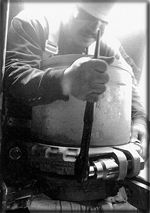 |
 |
 |
The Daily Journal |
| |
After a four-year hiatus, the Terminal Water Sculpture at Denver International Airport is under construction and scheduled for completion by the end of 1998.
The water sculpture will incorporate 3,100 vertical streams of water projecting upward to form a digital model of the Front Range of Colorado. Four pumps will provide around 6,000 gallons per minute of water through four 14 in. diameter supply pipes into a 17,000 gallon concrete, terrazzo and tile basin on the Terminal's main level. Sophisticated waterproofing, leak detection and leak repair systems were utilized in the design to inure the water tightness of the basin, which is situated directly over the terminal's train station. The design and construction of the project is being managed y Mark Kelly and Berrilee Nordhues of DMJM for the City and County of Denver. "Absolutely the most difficult aspect of this project is to maintain the artist's vision throughout the construction phases of the project," said Kelley, project manager for the city. "With the multitudes of detail in construction and coordination, it is important to maintain that vision and ensure the project is the aesthetic asset originally conceived by the artist." Called "Mountain Mirage" by artist Douglas Hollis of San Francisco, the water sculpture will be the centerpiece of three art works in the Great Hall of the Main Terminal. Working in concert with Anna Valentina Murch's "Skydance" and "Great Hall Floor" by Juane Quick-to-See Smith and Ken Iwamsasa, the three works relate to the unique clarity of light found in Colorado (the light feature) The contract for construction of the Terminal Water Sculpture project was awarded to Boscco Constructors Inc. of Englewood in March 1998. The project location, size and type construction provided Bosco with formidable challenges at every turn. Because of the project's location, the size and appearance of the construction barricade became both a means to provide a safe working environment and to inform the public of the work being done inside the barricade, as well as other projects throughout the airport. Forms this effort, the new DIA "Aviator" mascot was developed with the services of Robert Taylor Design of Boulder. With an average of 85,000 passengers passing through DIA daily, each step of the construction of the sculpture is an immense challenge. Meticulous scheduling and planning as well as infinite coordination with airport users, city maintenance and operations personnel is required for every step of the construction of both the fountain basin and its pump room located below the south security pavilion of the Main Terminal. In addition to all the challenges of an intricate construction project in the busiest section of one of the world's busiest airports, Bosco also had the daunting task of testing a piping system installed with the original construction of the airport four years ago. Pipe by pipe the work was pressure tested, evaluated for structural integrity and modified as needed to ensure the final installation met all the stringent standards required of a project of this magnitude. Over 30 days of testing and modifying piping, supports and restraining systems were spent to bring the supply and return piping into compliance. The heart of the sculpture is its sophisticated waterproofing systems. Because of the location of the project in the middle of a suspended structural floor, the basin had to be designed for flexibility as well as water tightness. Additionally, because of the sensitive location of the basin and the vibration it receives form the adjacent train system, it absolutely cannot leak. The solution is a double contained waterproofing system utilizing secondary containment system and lead detection. Between each layer of waterproofing are concrete slabs totaling nearly 10 cu. Yds of concrete, which Bosco place one wheelbarrow at a time - with a typical work day running between 10 p.m. and 6 a.m. Between the primary and secondary waterproofing membranes is a leak detection system that will alert airport maintenance personnel of a leak through the primary system. In addition to the primary and secondary waterproofing systems and the leak detection system, Bosco suggested a design improvement to include a leak repair system. The system was reviewed and approved by the city and was installed by Bosco through the numerous expansion joints and pipe penetrations. It will allow the city to perform lead repair work though a sophisticated injection product in the unlikely event it is needed in the future. The goal of the design team for the sculpture at DIA was to achieve the highest degree of safety and water tightness with an effortless and elegant fašade that belies the industrial aspects of the work. The exterior of the basin is terrazzo that matches the darkest colors of the existing Great Hall floor. The interior of the basin will be glazed tile that creates a mute background for the Front Range display provided by the 3,100 jets of laminar flow water. Eventually, a dynamic lighting scheme will be installed to illuminate "Mountain Mirage" and complete the work in the Great Hall. Design of the project was completed by Douglas Hollis, Waterscape Technology of Charsworth, California; Greenberg and Greenberg Architects; RoosSzyskie Inc. and Swanson and Rink Inc., all of Denver The City and County of Denver commissioned the project and formed the Airport Art Advisory Board in 1989 to review and select public art projects for the airport through the Percent for Art Program established y Mayor Wllington Webb and the Denver City Council. The art projects at DIA are administered by the Mayor's Office of Art, Culture and Film |
10 Inverness Drive East, Suite 100 Englewood, Colorado 80112 Phone: 303-799-1221 Fax: 303-799-4544 E-Mail: bosco@relay.hcp.net |